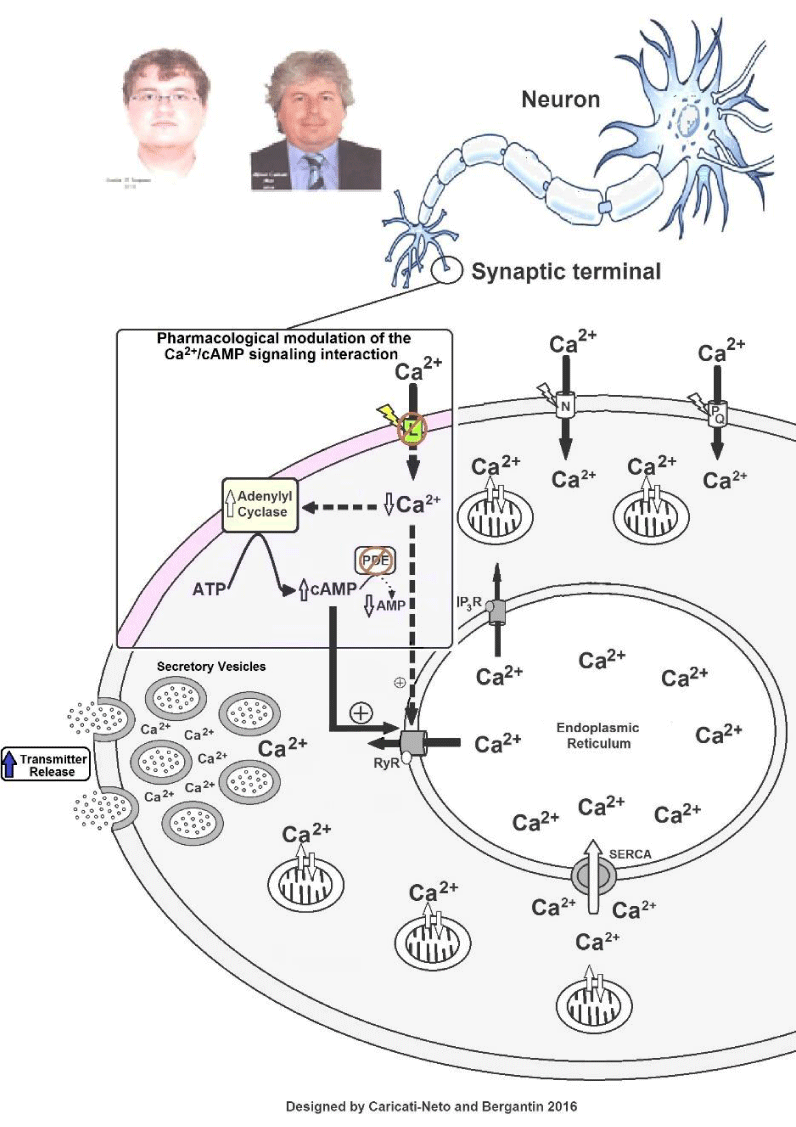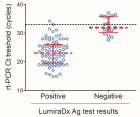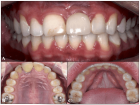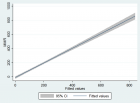Figure 1
Novel Challenges for the Therapeutics of Depression: Pharmacological Modulation of Interaction between the Intracellular Signaling Pathways Mediated by Ca2+ and cAMP
Afonso Caricati-Neto and Leandro Bueno Bergantin*
Published: 30 January, 2017 | Volume 1 - Issue 1 | Pages: 001-006

Figure 1:
Role of Ca2+/cAMP signaling interaction in the neurotransmission. In studies published in 2013, 2015 and 2016 (Caricati-Neto et al. 2015; Bergantin et al. 2013 2015 and 2016 a,b,c,d), we discovered that the paradoxical hyperactivity of sympathetic neurons produced by L-type CCBs results of its interference on the Ca2+/cAMP signaling interaction involved in the neurotransmitter release. The pharmacological manipulation of the Ca2+/cAMP interaction by combined use L-type CCBs and cAMP-enhancer compounds could be a new therapeutic strategy for increasing central serotoninergic and monoaminergic neurotransmission in depression. cAMP: cyclic adenosine monophosphate; ATP: adenosine trisphosphate; L-, N-, P/Q-type Ca2+ channels, IP3R: Inositol trisphosphate receptor; PDE: phosphodiesterase; RyR: ryanodine receptors; SERCA: sarco-endoplasmic Ca2+-ATPase. In addition, store-operated calcium entry (SOCE) is a ubiquitous Ca2+ entry pathway that is activated in response to depletion of Endoplasmic Reticulum-Ca2+ stores, and critically controls the regulation of physiological functions in cell types.
Read Full Article HTML DOI: 10.29328/journal.jatr.1001001 Cite this Article Read Full Article PDF
More Images
Similar Articles
-
Novel Challenges for the Therapeutics of Depression: Pharmacological Modulation of Interaction between the Intracellular Signaling Pathways Mediated by Ca2+ and cAMPAfonso Caricati-Neto,Leandro Bueno Bergantin*. Novel Challenges for the Therapeutics of Depression: Pharmacological Modulation of Interaction between the Intracellular Signaling Pathways Mediated by Ca2+ and cAMP . . 2017 doi: 10.29328/journal.jatr.1001001; 1: 001-006
-
Psychosocial factors among end-stage kidney disease patients receiving hemodialysis treatment in Kumasi, GhanaThomas Nti Amoako*,Frances Emily Owusu-Ansah. Psychosocial factors among end-stage kidney disease patients receiving hemodialysis treatment in Kumasi, Ghana. . 2021 doi: 10.29328/journal.jatr.1001017; 5: 014-019
-
Drug Rehabilitation Centre-based Survey on Drug Dependence in District Shimla Himachal PradeshKanishka Saini,Palak Sharma,Bhawna Sharma*,Atul Kumar Dubey,Muskan Bhatnoo,Prajkta Thakur,Vanshika Chandel,Ritika Sinha. Drug Rehabilitation Centre-based Survey on Drug Dependence in District Shimla Himachal Pradesh. . 2025 doi: 10.29328/journal.jatr.1001032; 9: 001-006
Recently Viewed
-
The Ketogenic Diet: The Ke(y) - to Success? A Review of Weight Loss, Lipids, and Cardiovascular RiskAngela H Boal*, Christina Kanonidou. The Ketogenic Diet: The Ke(y) - to Success? A Review of Weight Loss, Lipids, and Cardiovascular Risk. J Cardiol Cardiovasc Med. 2024: doi: 10.29328/journal.jccm.1001178; 9: 052-057
-
Could apple cider vinegar be used for health improvement and weight loss?Alexander V Sirotkin*. Could apple cider vinegar be used for health improvement and weight loss?. New Insights Obes Gene Beyond. 2021: doi: 10.29328/journal.niogb.1001016; 5: 014-016
-
Maximizing the Potential of Ketogenic Dieting as a Potent, Safe, Easy-to-Apply and Cost-Effective Anti-Cancer TherapySimeon Ikechukwu Egba*,Daniel Chigbo. Maximizing the Potential of Ketogenic Dieting as a Potent, Safe, Easy-to-Apply and Cost-Effective Anti-Cancer Therapy. Arch Cancer Sci Ther. 2025: doi: 10.29328/journal.acst.1001047; 9: 001-005
-
Reliability and Diagnostic Performance of Transient Hepatic Elastography in Chronic Hepatitis C during the Training PhaseAppel F*, Ercolin S, Monteiro MM, Lomes N, Uehara S, Emori CT, Nunes EJS, El Bacha I, Oliveira AC, Feldner ACCA, Silva ISS, Silva AEB, Ferraz MLG, Parise ER, Carvalho-Filho RJ. Reliability and Diagnostic Performance of Transient Hepatic Elastography in Chronic Hepatitis C during the Training Phase. Ann Clin Gastroenterol Hepatol. 2024: doi: 10.29328/journal.acgh.1001047; 8: 021-027
-
Mesenchymal Stem Cell Therapy for Hepatic Encephalopathy Due to Advance Liver Cirrhosis: Case StudyMegha Patel, Ankur Patel, Prashant Kshatriya*. Mesenchymal Stem Cell Therapy for Hepatic Encephalopathy Due to Advance Liver Cirrhosis: Case Study. Ann Clin Gastroenterol Hepatol. 2024: doi: 10.29328/journal.acgh.1001046; 8: 017-020
Most Viewed
-
Evaluation of Biostimulants Based on Recovered Protein Hydrolysates from Animal By-products as Plant Growth EnhancersH Pérez-Aguilar*, M Lacruz-Asaro, F Arán-Ais. Evaluation of Biostimulants Based on Recovered Protein Hydrolysates from Animal By-products as Plant Growth Enhancers. J Plant Sci Phytopathol. 2023 doi: 10.29328/journal.jpsp.1001104; 7: 042-047
-
Sinonasal Myxoma Extending into the Orbit in a 4-Year Old: A Case PresentationJulian A Purrinos*, Ramzi Younis. Sinonasal Myxoma Extending into the Orbit in a 4-Year Old: A Case Presentation. Arch Case Rep. 2024 doi: 10.29328/journal.acr.1001099; 8: 075-077
-
Feasibility study of magnetic sensing for detecting single-neuron action potentialsDenis Tonini,Kai Wu,Renata Saha,Jian-Ping Wang*. Feasibility study of magnetic sensing for detecting single-neuron action potentials. Ann Biomed Sci Eng. 2022 doi: 10.29328/journal.abse.1001018; 6: 019-029
-
Pediatric Dysgerminoma: Unveiling a Rare Ovarian TumorFaten Limaiem*, Khalil Saffar, Ahmed Halouani. Pediatric Dysgerminoma: Unveiling a Rare Ovarian Tumor. Arch Case Rep. 2024 doi: 10.29328/journal.acr.1001087; 8: 010-013
-
Physical activity can change the physiological and psychological circumstances during COVID-19 pandemic: A narrative reviewKhashayar Maroufi*. Physical activity can change the physiological and psychological circumstances during COVID-19 pandemic: A narrative review. J Sports Med Ther. 2021 doi: 10.29328/journal.jsmt.1001051; 6: 001-007

HSPI: We're glad you're here. Please click "create a new Query" if you are a new visitor to our website and need further information from us.
If you are already a member of our network and need to keep track of any developments regarding a question you have already submitted, click "take me to my Query."

















































































































































